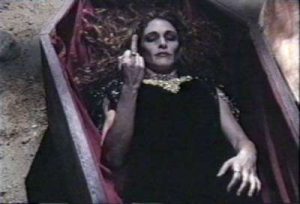In Bram Stoker’s Dracula and Vernon Lee’s “Dionea” both authors depict women as beautiful creatures. Stoker does this through the three female vampires and Lee achieves this with his titular character. Within these two texts, the beauty of those characters leads to destruction. Stoker depicts this when Van Helsing must murder the female vampires, whose vampirism is visible through their beauty. On the other hand, Lee demonstrates destruction through Waldemar’s failed attempt to capture Dionea’s beauty in his sculpture. Within both of these texts, beauty is used as the conduit in which women are given power over men. However, in order to maintain the social decorum of the 19th century, that power and subsequently that beauty must be destroyed so men can stay in power.
Within Dracula, the female vampires are seen as beautiful as a result of their vampirism. Van Helsing knows that youthfulness and beauty is a characteristic of vampirism, but the female vampires beauty still stops him when he is trying to kill them. Van Helsing recognizes that “the mere beauty and fascination of the wanton Un-dead have hypnotize him” and that if he were to keep dawdling in his task he could become “one more victim in the Vampire fold” (Stoker 393). In this quote, the vampires’ beauty is so strong that it has “hypnotized him” and stopped him from completing his task. The power of the vampires’ beauty demonstrates the potential danger for Van Helsing. If he keeps staring at them, the sun will eventually set, and he will become “one more [of their] victim[s]”. In order to prevent that, Van Helsing must destroy the vampires and their beauty in order to be free from their power. This interaction between Van Helsing and the female vampires shows that the kind of power women had over men had to do with looks. The female vampire would only be successful in turning Van Helsing if he succumbed to their beauty. He is able to prevent that though by killing them, which demonstrates Stoker correcting the power dynamics within the novel by transferring it back to the man.
Vernon Lee’s “Dionea” depicts beauty in a similar way to Dracula. Dionea is seen as a witch or possessing the evil eye, but the doctor always describes her as beautiful. While Dionea’s evilness is never given a name like vampirism, it is clear through her interactions with Waldemar that her beauty has power over men. This is seen when Waldemar is attempting to model a sculpture after her but is not successful: “she is far, far more beautiful than Waldemar’s statue of her. He said so angrily, only yesterday…as he spoke that odd spark of ferocity dilated in his eyes, and seizing the largest of his modelling tools, he obliterated at one swoop the whole exquisite face” (Lee 23). Waldemar knows that his sculpture is not doing Dionea’s beauty justice, which is represented through his saying that in real life Dionea is “far, far more beautiful” than what his sculpture currently depicts. The power of Dionea’s beauty creates an “odd spark of ferocity” within Waldemar, which drives him to destroy his sculpture. While Stoker was able to fix the power dynamics in his novel, Lee is not able to do the same. Instead, Waldemar dies as a result of Dionea’s power and beauty and she is left standing triumphant in the end.
While both of these texts represent beautiful women who are subsequently given power, they have very different results. Stoker corrects the power dynamics in Dracula when Van Helsing successfully kills the female vampires. However, Lee’s Waldemar fails fatally to Dionea’s beauty and power. Both representations of characters though goes against the social codes of the 19th century by giving women power over men, even if it is through shallow descriptions of beauty.


